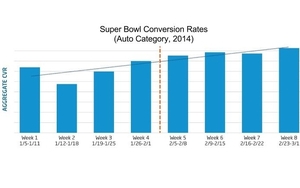Can we agree that Super Bowl advertising has jumped the shark? That though the Big Game may remain the advertising industry’s biggest stage, it may not be advertisers‘ wisest investment?
With each passing year, Super Bowl advertising rates rise just as their effectiveness as a marketing vehicle diminishes.
Super Bowl Advertising Rates, 2005-2014
It is significant that the table above covers Super Bowl ad rates beginning in 2005, the year YouTube was launched. YouTube is in large part to blame for the diminishing efficacy of TV advertising during the game. That fact is, by the time Super Bowl Sunday rolls around, we’ve likely seen or heard about most of the ads that will air tonight.
If we care about them at all, we can watch them on our terms and devote our attention to the actual game. According to iSpot.tv (via MediaPost), through Thursday, there have been some 103 million video views of Super Bowl ads, up from 69.2 million a year ago, with 35% of Super Bowl ad plays on Facebook. YouTube is also a major contributor to video views total. MediaPost also reports:
There have also been 3.1 million social actions — shares, likes, comments, tweets, and other activities around Super Bowl commercials — up from 1.6 million a year ago. There have been 1.2 million searches for specific TV commercials — more than double the 565,000 of a year ago.
On yesterday’s Beyond Social Media Show broadcast, we discussed two Super Bowl advertisers tactics for generating buzz before the game. GoDaddy “pulled” a controversial ad and Budweiser released their ad a few days before the game:
The NFL has managed to turn their championship match into an unofficial national holiday and, as such, many people use it as an excuse to throw a party for friends and family.
How People Actually Watch The Super Bowl
The way the Super Bowl is actually experienced is much like how Ze Frank narrates the Friskies Dear Kitten video “Regarding the Big Game.”
During the actual action, there’s a lot of commotion and running commentary but when the action stops, when the ads start, the commentary continues. So even for those people who want to watch the ads, they’ll need amazing powers of concentration to follow them amidst all the din. Add to that chaos the fact that many of us will turn to social media during commercial breaks to tease and taunt our friends or just see what others are saying about the game.
Another issue advertisers face is the fragmentation of audiences and competing venues. Not only may viewers be preoccupied with social media while their ads air, they may actually tune out the game in tune in alternate programming, such as YouTube’s alternative halftime shows. Or they may simply time-shift the game and fast-forward through the commercials.
The big moment on advertising’s biggest stage was Apple stealing the show in 1984 with the eponymous ad that famously aired once and only once during the Super Bowl.
But that was before the Internet, when the game commanded much more of our attention. Before audiences began to fragment. Before alternative media gave us more choices for our amusement. And before analytics could actually measure the effectiveness of advertising.
Super Bowl Advertising Conversion Rates
The problem with television advertising for advertisers is that it is far more difficult to measure ROI than the online alternatives they now have at their disposal.
Minneapolis retailer Best Buy has decided to sit out the Super Bowl ad fest for the second year in a row in favor of digital media, which they believe will have a better payoff.
The most damning evidence to date, though, may be MediaPost’s analysis of automotive Super Bowl advertisers’ conversion metrics for the eight weeks following the 2014 Super Bowl.
Quoting the article:
Initial findings appeared to support the notion that Super Bowl advertising had a positive impact on conversion rates. Auto advertisers who advertised during the game averaged 14.9% higher conversion rates in the four weeks following the Super Bowl (February) compared to the four weeks prior (January). This effect was even stronger if they weren’t advertising a luxury vehicle.
However, plotting the conversion rates for these campaigns by week told a different story:
If Super Bowl advertising were actually driving greater conversion rates due to a sort of halo effect, then we might expect to see a significant increase immediately following the game, rather than a gradual upward trend that appears to have started in January. This led us to investigate the standard sales cycle for cars over that same period. Using data from Edmunds.com for sales in early 2014, we found that this increase in conversion rates simply mirrors the monthly industry-wide sales data. This suggests that auto advertisers get little to no additional value from their February advertising as a result of Super Bowl advertising.
So I ask again: Can we agree that Super Bowl advertising has jumped the shark?
The e-Strategy Academy covers all aspects of digital marketing including search optimization & marketing, email marketing, social media marketing, video marketing, mobile marketing & public relations.

